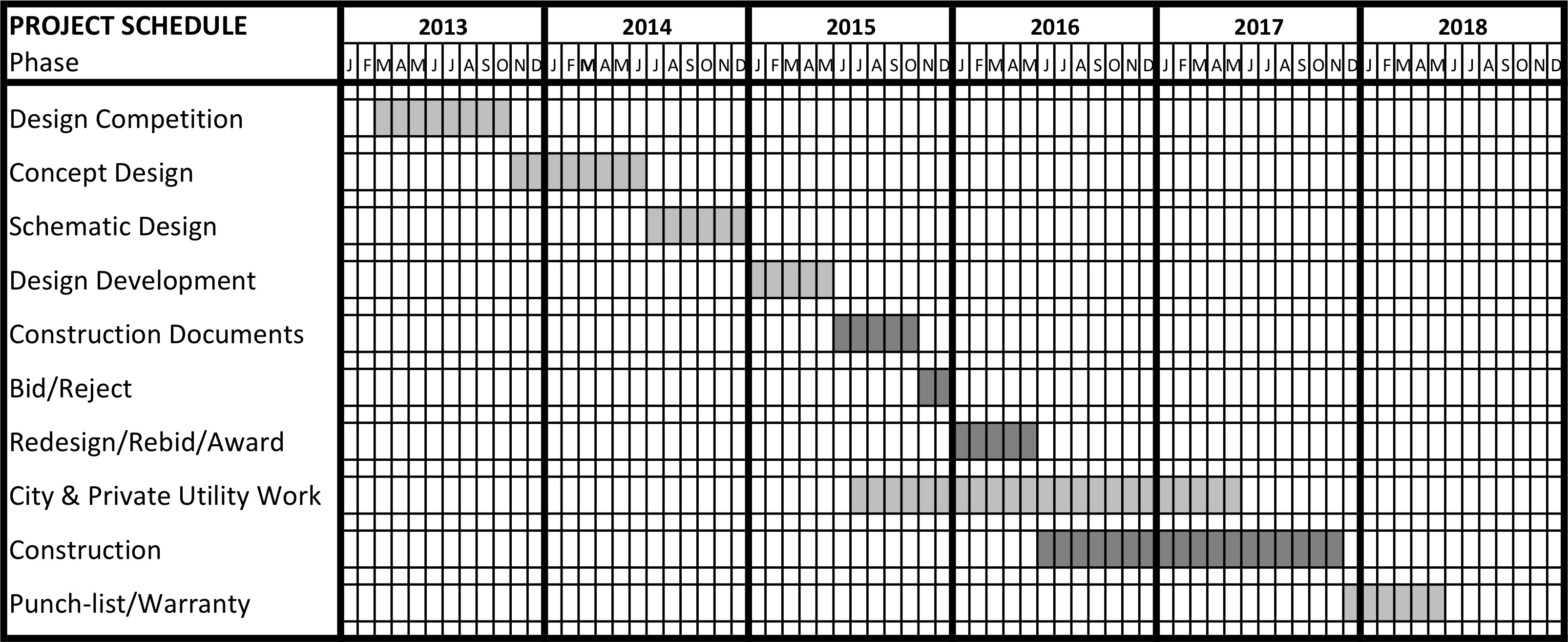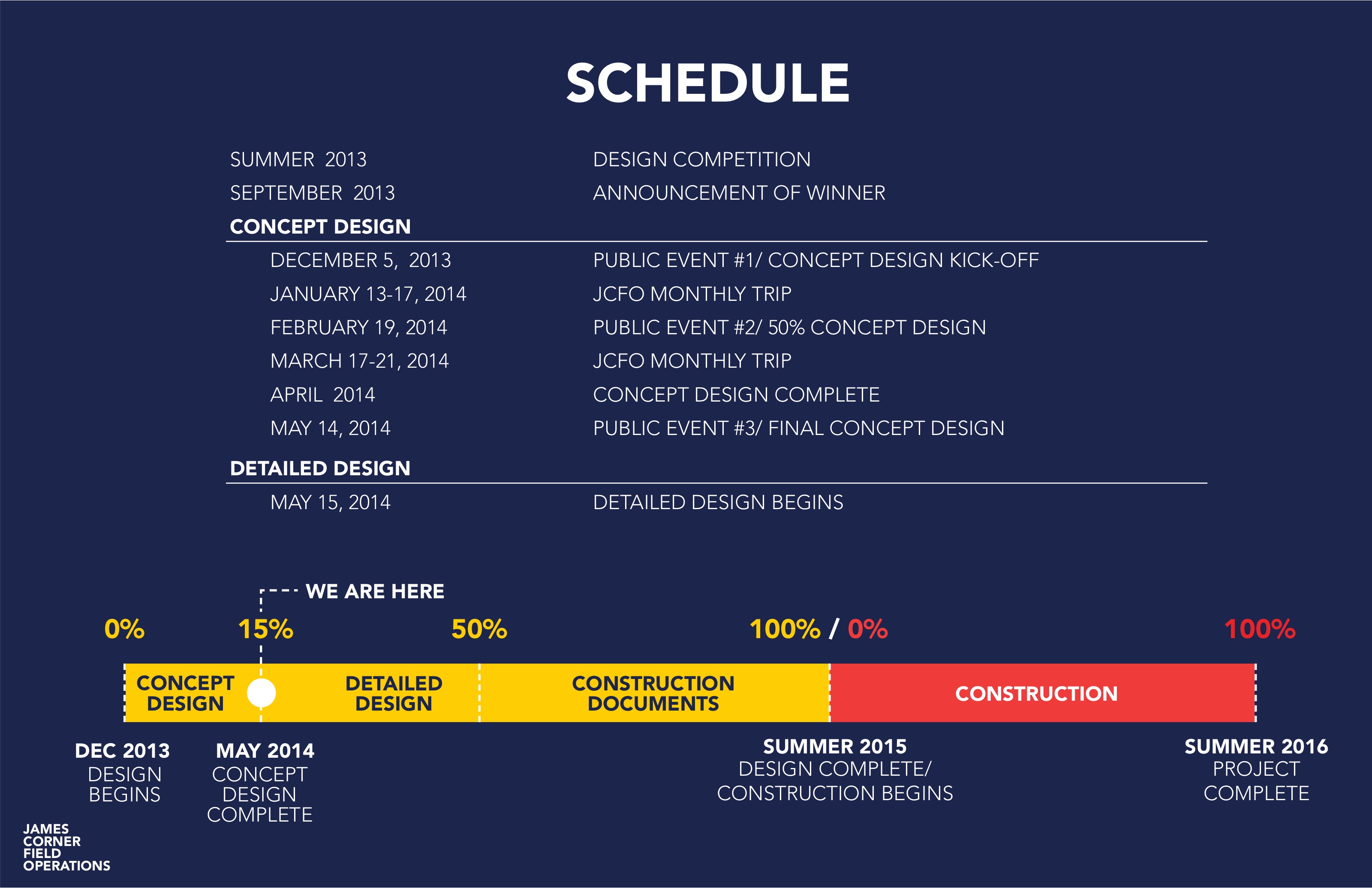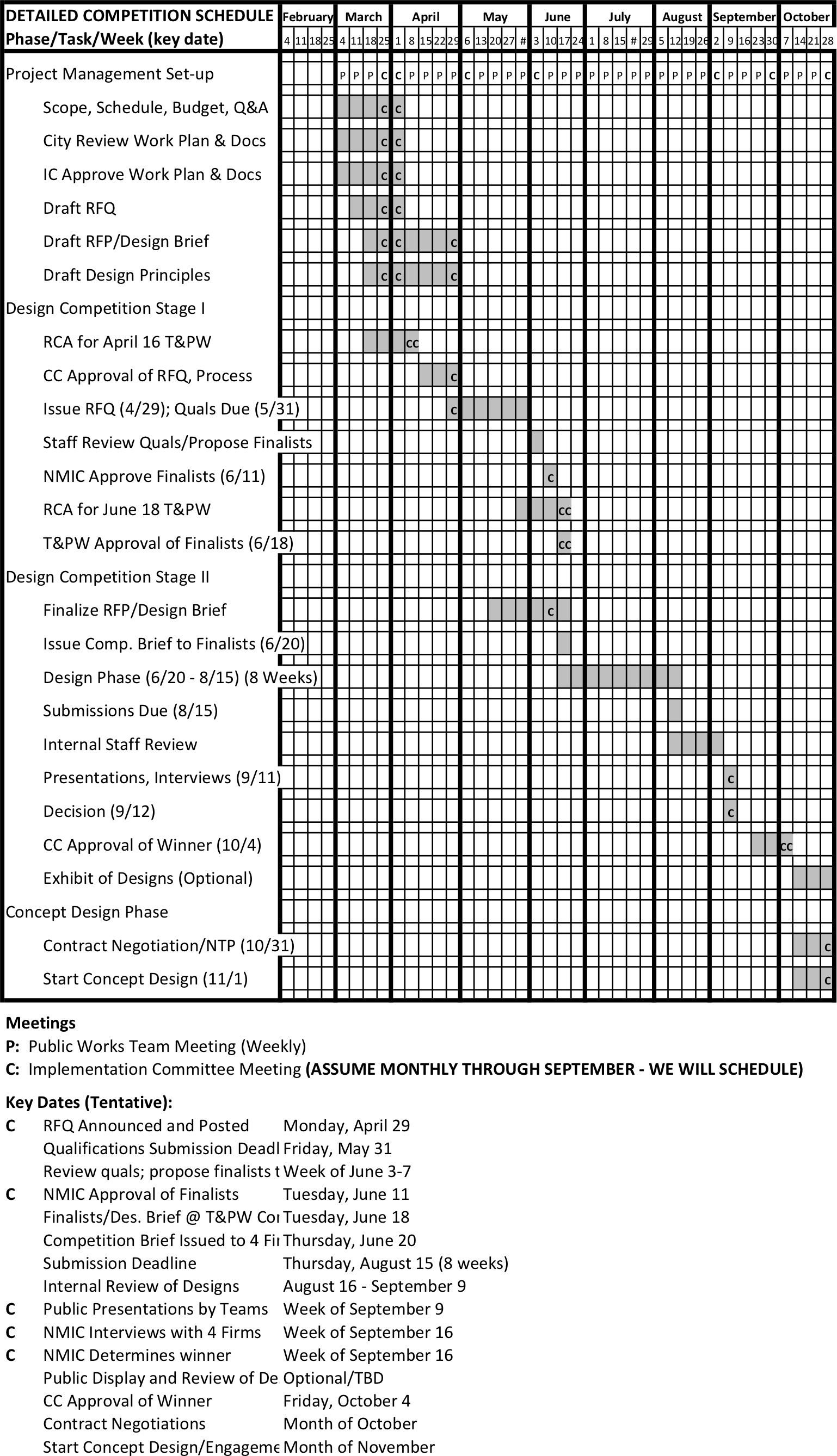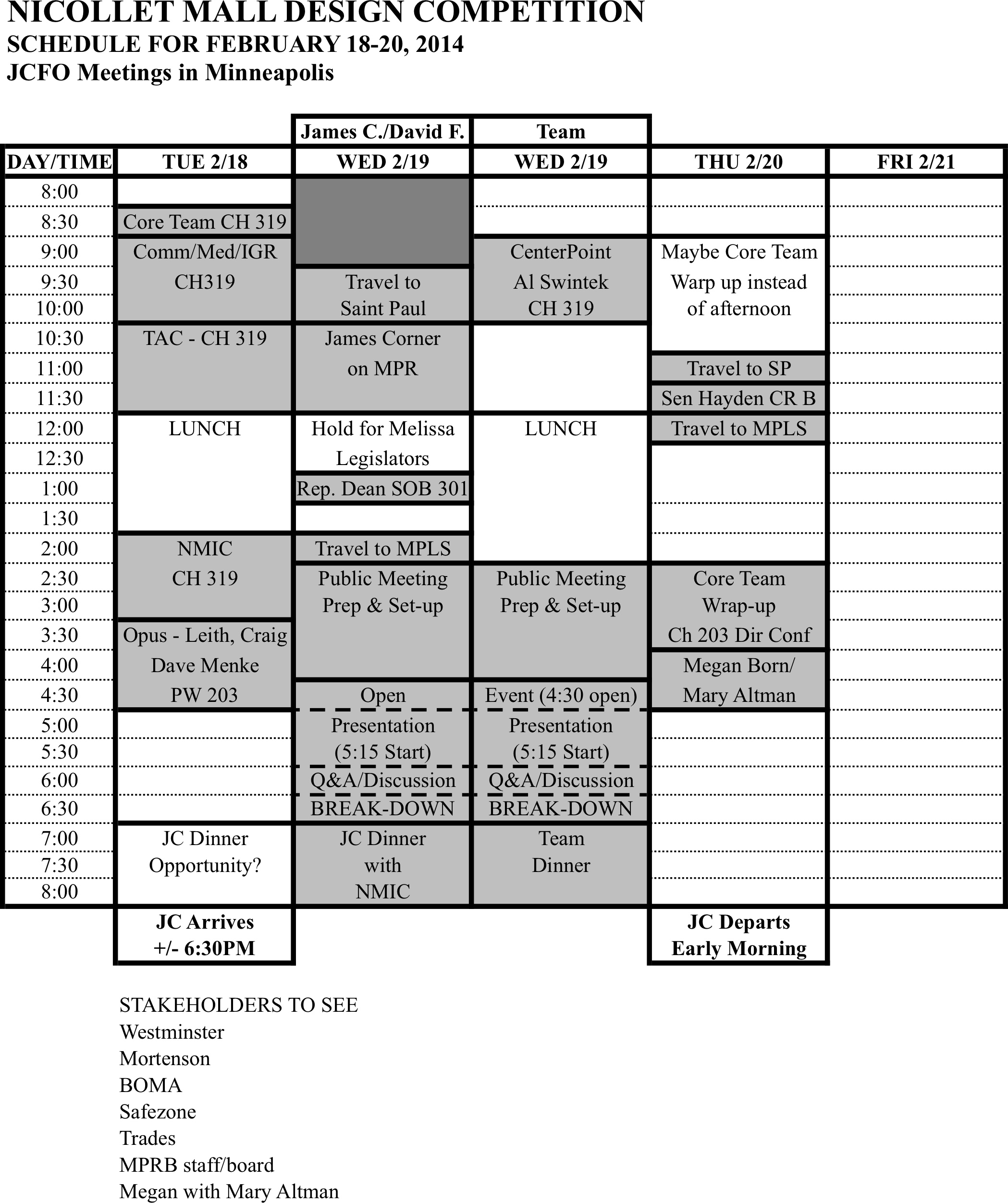1.8 Exhibits: Schedules
Types of Schedules
- Macro/conceptual schedule (the entire project duration)
- Micro/detailed schedule (a discrete phase, part, or process)
- Graphic timeline schedule (for use in public meetings)
- Detailed meetings schedule (for managing a large design team from out of town)
- Stakeholder engagement schedule (for event, communications, media planning)
The following examples illustrate several types of schedules for use in project planning and management. I use the terms “macro” and “micro” to differentiate between simple overall schedules for use in explaining the project to stakeholders and the public and detailed schedules created for the purpose of mapping out all of the steps and processes in one phase of a project for use by the project team. When the design team is from out of town, one effective approach is to schedule several days of meetings every month when the team will be in town. Each month there is an agenda and a set of goals and objectives as well as a meeting schedule designed to share and collect as much information as possible in a compressed time frame. For this kind of process to work a carefully organized meeting schedule maximizes the value of that team’s visit.
Below are the original schedules for the Nicollet Mall project in Minneapolis. These schedules were created at the very beginning of the project as a part of the competition planning process. The first three schedules are “macro” schedules that offer a conceptual timeline for the entire project from beginning to end. The first schedule is the very first one created for the internal project team in March 2013. The second schedule is a revision to the same schedule, four years later, in the summer of 2017, when the project was almost complete. The third schedule is is a simple graphic version that was used in public presentations in 2014.
The schedule changed significantly between 2013 and 2017 and construction was finished about sixteen months later than originally planned. There were two big schedule “busts”: 1) The elimination and redesign of a major feature (the “island,” including grand stairways from the street up to the skyways), which took about four extra months, and 2) The overall redesign and rebidding of the construction documents after the first bid process yielded only one bid that was much higher than estimated (the bids were expected to come in around $35M and the one bid the city received was for $59M). Redesign and rebidding took another four months.
Weather is an issue for road projects and while the project team had planned to begin construction in late March to get a full season in, (the season for outside work in Minneapolis runs April 1 through November 30), rebidding meant contracting in May (rather than January) so the construction start date slipped to June. Even then, that first year was slow because by the time the project had been rebid, most contractors had already won enough work to “fill their work pipelines” for the season so the winning contractor’s plan was to get started slowly during that first year and then to really hit it hard and finish it all with a full construction season the following year. Together, these delays cost a full season, and that added time too.
The Macro Schedule – Three Versions


Macro Schedule – The Public Version, Spring 2014

Detailed Schedule
Detailed Schedule – The Design Competition Phase
The key milestone at the start of the Nicollet Mall project was the selection of a design team by fall 2013. The reason was simple: Mayor RT Rybak’s term was coming to an end in November and he had decided not to run again but he had a personal stake in successfully launching the project before the November election and the end of his term the following January. Planning started in March and it took every bit of effort to successfully complete the competition before Rybak went out of office in January 2014.
A central part of the plan was obtaining a large grant from the state – the Minneapolis Department of Employment and Economic Development (DEED) – in the upcoming legislative bonding bill which would be passed at the end of the legislative session in May 2014. The City hoped to win a grant from the state that would cover half of the project cost – $25M on a $50M project budget. Timing of grant requests is important, too, because the state legislature traditionally only passes bonding bills in even-numbered years and elections for state representatives occur every two years (also in even-numbered years), which means that the make-up of the house can change between bonding bills, increasing or decreasing a project’s chances of receiving funding. So, if you don’t get the grant this time, you don’t know who will be deciding next time, which is a long two years away.
Indeed, the City had made a request for a grant for Nicollet Mall in the previous bonding bill cycle, in 2012, and received no funding, in part because the legislators felt there was not much of vision, so they didn’t understand the need for the project and the funds. Mayor Rybak knew that the city needed the funds from the state and that the City would need a very compelling vision in order to get those funds. After twelve years as mayor, he also knew what was involved, he had a lot of good will and political capital and influence at the state level, and he knew that if he didn’t get it started, it may languish for several more years as the next mayor determined his or her own priorities.
The following schedule was created in March 2013 for the purpose of determining if the project team (which was then three people) could meet the mayor’s schedule and, if so, which pinch points and critical path items required immediate attention. This is a detailed version of the bar on the above macro schedules called “Design Competition” (March-October, 2013). The project team met and revised this schedule every week for seven months.
The biggest issue was that a large number of people had to meet repeatedly and approve decisions to allow the project to keep moving. These people included key individuals, key city council-members, and key council committees including the Transportation and Public Works (T&PW) committee, the Ways and Means and Budget (W/M&B) committee, the Committee of the Whole (COW) and the full City Council. The project team also had regular meetings with the public-private “Nicollet Mall Implementation Committee (“NMIC”) over this period (The nine-member NMIC was comprised of five elected officials and four representatives of the business community). Those groups all meet on cycles based on a monthly schedule and the project team had to fit the work to those schedule and dates. Some people are harder to schedule than others and often those are the people who are most important to have in the room. A meeting that is missing a key decision maker is a meeting that you must have again when that person is available, or you must at least find a way to brief that person on the side and secure their support.
Finally, the schedule had to accommodate the proposing design teams, all of which were from out of town. The project team expected them to visit for an informal tour and meeting and then come back for a final interview and public presentations at the Guthrie Theater. There were four finalists from around the country (one dropped out so then there were three) and the design of the schedule had to allow each design team enough flexibility to make sure their key people could all be in town.

Detailed Meeting Schedules
Once City’s project team had hired the winning design team, which was led by the New York-based landscape architecture firm of James Corner Field operations, they had to develop a schedule of meetings that maximized the productivity of their time when they came to visit, usually for 3 days, once a month. The idea was that the one-month work cycle would be based on three weeks’ work and preparation followed by an intensive week of meetings, including travel time. The following two meeting schedules show how the project team used a carefully crafted schedule each month to maximize the value of the team’s time together and accommodate a wide variety of stakeholders, down to and including lobbying state legislators at the capitol in Saint Paul. Because so many people were involved, these schedules were very difficult to set up and so the project team started planning the next month’s schedule in the last meeting of the current month, before the design team had left for the airport to go home and work for the next three weeks.

The project team also planned lunches every day (if you skip lunch people get low on calories, they get “hangry,” and everyone falls apart) and one dinner with the design team each visit, so that everyone could get to know one another. Team bonding is a good investment because, while it is all fun and games in the early days, when something goes wrong halfway through the project, you want to know one another – and be committed enough to one another – to pull together and succeed together, and that will not happen if you haven’t already built trusting relationships. After signing the Declaration of Independence, Benjamin Franklin said to his fellow conspirators, “We must, indeed, all hang together, or most assuredly we shall all hang separately.” This sentiment holds for any team that hopes to complete a project successfully.
